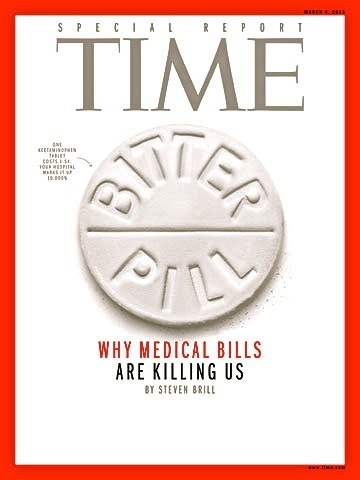The Cost of Medical Care

Steven Brill’s “Why Medical Bills Are Killing Us” may be the longest article ever to appear in Time magazine. The 39 page article in the March 4 issue is not cluttered with distractions. There are 11 full page pictures and a few scattered reproductions of parts of hospital bills. That and wide columns of detailed reading.
Brill concentrates most of his attention on hospitals. He includes for profit institutions and the not-for-profit conglomerates, including MD Anderson headquartered in Houston.
Until the last few pages, he seems to be applying sound business principles to his analyses. In the end, however, his cover is broken. His suggestions for possible corrective action indicate that he may never have been in a management position in any business and that he believes the government is the answer to every problem.
Then, after some calm reflection on the entire article, clearly the major cause of escalating medical costs is understated or ignored completely. Instead of the government being a solution for the problem, it is the principle cause of the problem.
Throughout the article, Brill lays blame on chargemasters. Chargemasters are the computer billing programs for hospitals with an amount listed for thousands of individual procedures, medications, supplies, etc. Each hospital and hospital system has a unique chargemaster developed for and by the institution. In nearly every instance, the amount listed has no basis in reality. Each of those amounts could be called obscenely high.
Analyzing why those amounts are so grossly exaggerated leads to one conclusion. The primary reason is the government’s intrusion.
There were many huzzahs and hurrays when Uncle Sam announced that it was going to help seniors pay for their medical care. Then the reality of Medicare set in.
The government was going to pay 80% of the charges it deemed reasonable. Reasonable charges would be discounts of the average of charges for a procedure or bill within specific regions.
Hospitals wanting a reasonable return on their investments, therefore, had to do whatever possible to raise the “average” in their region. That meant everyone pegging their chargemaster prices as high as possible and then negotiating with the government and insurance companies to obtain that discounted rate.
Bills churned out by chargemasters, however, are rarely paid in full. Patients who normally pay in full are wealthy foreigners and unknowing or uncaring Americans.
The government and insurance companies know those chargemaster bills are mere starting points for negotiations and rarely, if ever, pay as much as one half of the bill.
The system has also spawned a new cottage industry.
Knowledgeable and experienced individuals are now becoming representatives for uninsured patients presented with massive hospital bills in six figures. The representatives take the bills apart line by line and frequently end up with the patient paying no more than the government or insurance companies would pay under their negotiated fees.
The escalating fees will be exacerbated by Obamacare. The new law is already bringing more Americans under the government’s or insurance umbrella. When complete, every American will be covered by Medicare, Medicaid, or insurance.
Everyone will be lulled into thinking that medical care is now free or almost free and do what many people do when they think something is free. They will use it, without regard to whether they really need it.
Two other factors that Brill discusses in relation to exorbitant hospital bills are the million dollar salaries for the non medical administrators of hospital systems and run amok personal injury lawyers.
Some of the million dollar salaries are mind boggling. Consider, for example, MD Anderson in Houston. According to Brill, “Ronald DePinho’s [President of MD Anderson] total compensation last year was $1,845,000. That does not count outside earnings derived from a much publicized waiver he received from the university that, according to the Houston Chronicle, allows him to maintain unspecified “financial ties with his three principal pharmaceutical companies.”
“DePinho’s salary is nearly triple the $674,350 paid to William Powers Jr., the president of the entire University of Texas system, of which MD Anderson is a part.”
The nauseating nightly TV ads for law firms urging anyone who has not been made completely whole by any medical procedure to contact them “for the compensation you deserve” has been discussed here too often to require repeating. Just talk with any physician about what that constant threat of malpractice law suits requires them to do above and beyond what they think is reasonably required. Each Xray, MRI, and Cat Scan they require “just to be sure” does nothing in most cases but add to the patient’s bill.
So here’s the perspective.
Brill’s article is a good read on how and why American medical bills are so much higher than the rest of the industrialized world. He also has some ideas on how some of those bills might be reduced.
One of his suggestions, however, goes too far. He would have the government cap the salaries for hospital administrators.
Whenever the government starts stepping into office buildings and telling businesses what they may pay their executives, we are in deep trouble.
enough





